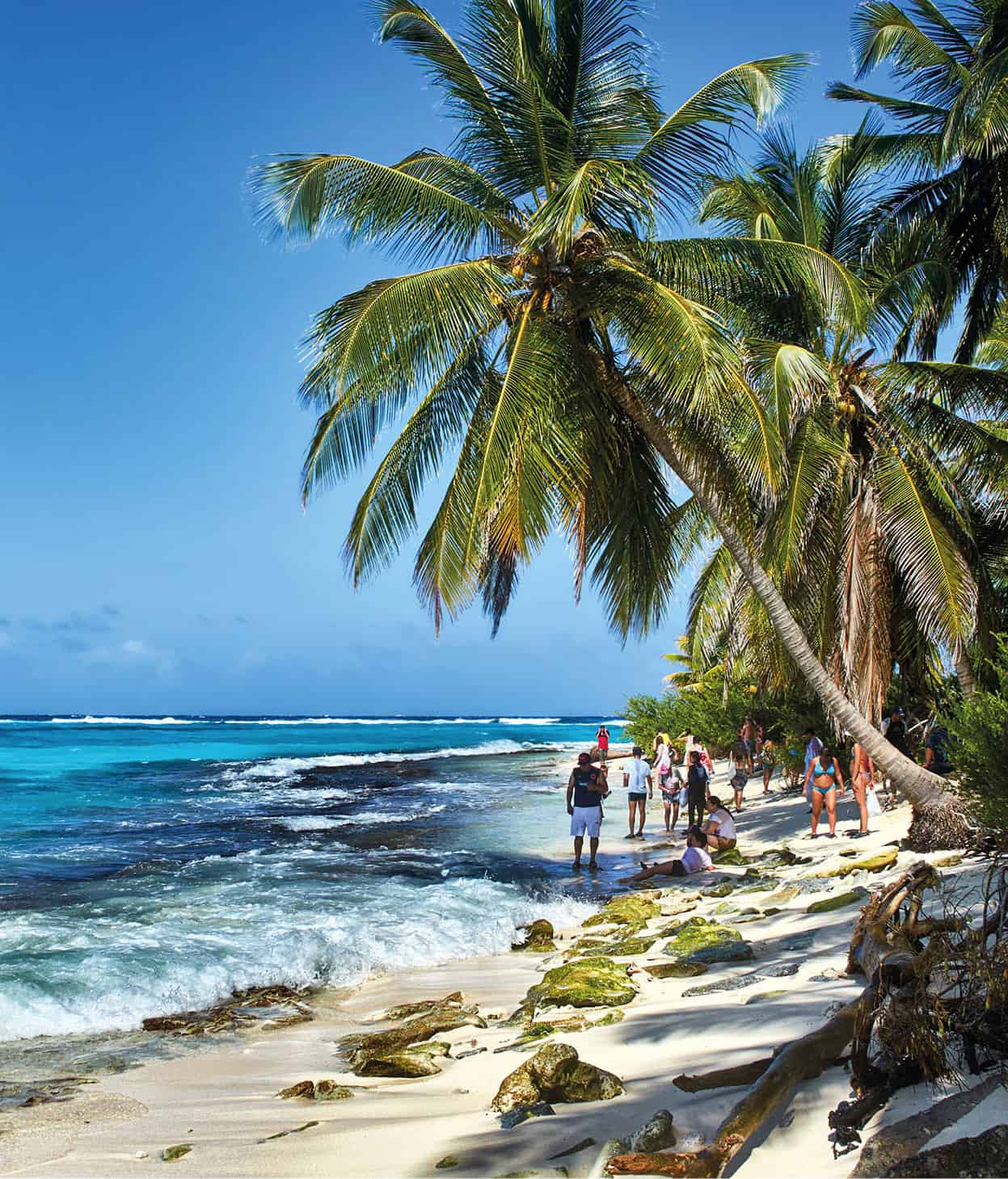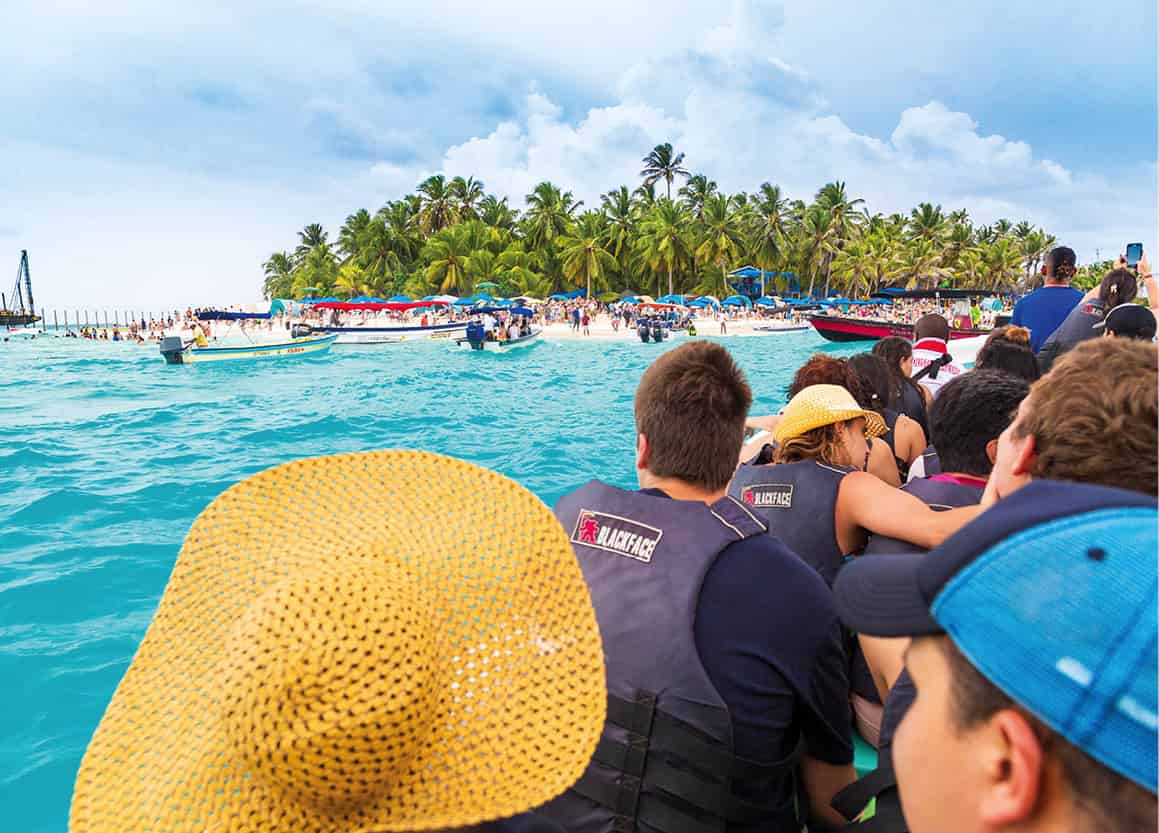The 11km (7-mile) -long island of San Andrés may be small, but it has a rich history filled with slavery, swashbuckling, power grabs, and maritime border disputes. It seems at some point or another everyone has wanted a piece of this idyllic coral island. Christopher Columbus was the first to spot it, way back in 1503. Then British Puritans arrived and kicked out the early Dutch settlers during the early 17th century. English ship owners brought West African slaves to the island via Jamaica shortly after to work the cotton and tobacco fields. Soon the Spanish attacked and the pirates followed hot on their heels. San Andrés appealed to pirates because it made for a strategic base of operations from which to launch raids on mainland cities and settlements – as well as attacks on Spanish galleons, which were loaded with gold.

Johnny Cay.
Shutterstock
The British managed to hold the islands for a chunk of time in the 18th century. However, in 1802, in a strategic move, they requested the archipelago be placed under the purview of the Viceroyalty of New Grenada, as Colombia had not yet been formed. Then, in 1818, with revolution in the air, Simón Bolívar’s pro-independence forces occupied the island. By the time Gran Colombia had drafted its first constitution in 1821 the writing was on the wall, and by 1822 San Andrés, neighboring Isla Providencia, and the whole of the archipelago were part of the new republic.

Diving off San Andrés.
Shutterstock
The seeds for future territorial disputes were planted when Panama broke off from Colombia in 1903. In a not-exactly-wild coincidence, envoys from US President Theodore Roosevelt’s administration arrived by boat the very same year to request that the islands become part of Panama. The locals refused and declared their loyalty to Colombia. By 1928 treaties had been signed stating that certain countries – namely Panama and Nicaragua – would keep their hands off certain Caribbean islands – namely San Andrés and Isla Providencia. This lasted until 2001 when Nicaragua decided that the treaty they signed in 1928, known as the Esguerra Bárcenas Treaty, was null. The Hague disagreed, and in 2007 the issue was finally settled in Colombia’s favor. However, tensions still remain, and Colombia maintains a small offshore military presence as security.
Pirates of the Caribbean
As with most events concerning Colombia’s early history, gold – or rather the desire for it – was an important motivation for the country’s new arrivals. Of course back in the 17th century San Andrés wasn’t part of Colombia, as Colombia did not yet exist as a country. Nor was gold ever actually found on San Andrés. However, that didn’t stop the Welsh pirate Sir Henry Morgan from establishing a base here and ransacking every gold-carrying Spanish Galleon he happened across. When there were no Spanish ships left to pillage, or when Sir Henry simply got bored, he and his men would head over to the mainland and raid cities and settlements such as Santa Marta and Panama, relieving locals of their gold and other valuables. A life of piracy – sanctioned or otherwise – eventually took its toll on Morgan, and one day he decided to change his ways and leave his old life of crime and piracy behind him, purchasing three sugar plantations in Jamaica. Morgan managed to change his image so much that he was eventually made Lieutenant Governor of Jamaica. The gold he pilfered during his time as a pirate in the Caribbean was never fully accounted for. According to legend, it can still be found in an underwater cave off the coast of San Andrés.
All of this history has led San Andrés to become what it is today: a Unesco Biosphere Reserve that boasts some of the most stunning beaches anywhere in the Caribbean, as well as world-class diving off the third-largest barrier reef in the world. It’s also a cultural hotbed, with about 50 percent of the 80,000-strong population representing immigrants from the mainland, while the remaining 50 percent are comprised of descendants of Jamaican slaves whose genealogy is a mix of early French, Dutch, Spanish, and English settlers. In fact, despite most of the British leaving in the 1600s, the original Creole English is still part of the culture today. Many locals do indeed speak Creole, which should be refreshing to those American or British visitors whose Spanish isn’t exactly up to scratch and who’d like to converse with locals in their native tongue for a while.
The unique and eclectic genealogical make-up of the islands has resulted in a distinct variety of musical influences, all of which can be heard on San Andrés. The rhythms of soca music, a form of calypso that originated in Trinidad and Tobago and is popular in Venezuela, are ubiquitous here. Also, various forms of polka, like schottische, as well as quadrille, are common and represent the island’s diverse cultural heritage. Even gospel music can be heard at Sunday services at the first ever Baptist church built on the island.

San Andrés hotel.
Shutterstock
How to get there and when to visit
San Andrés has always been a popular vacation destination for many Colombians, although most previously lacked the funds to make their dream of a Caribbean vacation come true. However, since Colombia’s tourism boom – plus the arrival of a national budget airline carrier and more frequent international flights to the area – it has seen an even greater influx of visitors. The island’s long distance from Colombia means the only practical way to get there is to fly, and with VivaColombia Airlines (for more information, click here), it has never been cheaper to purchase tickets. Be aware that upon arrival at the airport all foreigners are required to purchase a tourist card for around US$33. Do not lose it, as you will need to present it on your return flight. The card is also required if you wish to travel to Isla Providencia. Inter-island travel from San Andrés to Providencia is relatively easy, with cargo ships leaving the main muelle (dock) at the north end of the island.

Local woman serving food on San Andrés.
iStock
Finding your way around San Andrés Island
You’ll arrive in San Andrés at Gustavo Rojas Pinilla International Airport 1 [map] on the north end of the island, about 1km (half mile) from the main town. Your appetite for beach fun will likely be whetted before you even touch down, as a daytime descent affords aerial views of the various shades of blue and green surrounding San Andrés pristine white-sand beaches. A taxi to town shouldn’t cost more than US$3, and from here you’ll have your pick of hotels, hostels, and restaurants. Most of these are in San Andrés’ central commercial district, which is located on the northeast peninsula 2 [map] of the island.
Head north on Carrera 5, which leads all the way to the beach, and then stretches eastward along the top of the island. There’s also a tourist information kiosk 3 [map] here (daily 8am–8pm). Looking out from here, you’ll have a direct view of Johnny Cay 4 [map], which is one of the most popular playgrounds in the archipelago. Most people come to San Andrés because they want the pristine beach, and Johnny Cay is the most iconic atoll on the island, the one that you literally see on all the postcards. Fast water taxis leave from the Muelle Casa de la Cultura 5 [map] (Pier; Carrera 1, no. 21) and stop at the best cays: first to El Acuario and Haynes Cay, and then to Johnny Cay. The boats leave daily at 9am and 11am, returning at 3.30pm, costing US$10 for the round trip. Upon disembarking at Johnny Cay, you must pay an entrance tax of around US$3 to help maintain the island.
To the north of Johnny Cay is a rocky shore with plenty of tide pools. It’s a great place to take solitary photos of the surrounding sea and nature, as most visitors head for the south of the island. It’s at the south you’ll find all the thatched hut restaurants, beach bars and friendly Creole locals selling food and drinks and renting umbrellas and beach chairs. The water here is as drop-dead-gorgeous blue as anywhere else in San Andrés, but offshore winds make for some decent-sized waves, so Johnny Cay is much better for bodysurfing than it is for snorkeling. Big weekly beach parties are held here on Sundays.
To the west of the pier is Calle 1, a promenade that runs along the water and alongside clothes stores, pharmacies, and restaurants. There are also any number of street vendors here serving refreshing tropical cocktails. Follow the promenade around the peninsula and you’ll see plenty of shopping malls, restaurants, and cafés, all of which sit just behind palm-lined beaches dotted with outdoor bars. If you’re lucky, you’ll catch a Creole chef, often the mother or grandmother of the household, setting up pots and trays of fresh-cooked Creole-Caribbean fare on long tables in a buffet-style form of dining self-service. Delicacies include stuffed crab shells, fried breadfruit, conch, fresh island fish, and much more. This humble goodness might just be the best eating on the island.
As for transportation, there are plenty of places to rent golf carts, but most people choose to get around the island by motorcycle, moped, or public minibus. A single ride around the island costs around US$1.

Tourists arrive at Johnny Cay.
iStock
The east side
Those who want to get away from the relative hustle and bustle of San Andrés’ commercial district will want to head to the east side of the island. There are a number of cays located just offshore, as well as the rusted out hulks of once-great tankers. There are some small, quieter towns here; while the beaches are just as stunning as anything you’ll find on the north side of the island. There are also plenty of waterfront resorts for those who want to bask in the sun and enjoy the good life.
One great beach on the eastside is Playa Rocky Cay 6 [map], which is known for tranquil waters, as well as the tiny island of the same name that sits about 100 meters offshore. Everyday lines of people wade in single-files lines through the shallows of a submerged sandspit out to this cay. It makes for great photos, as a huge shipwrecks lies just behind the island. There are also a number of beach restaurants on shore that offer good meals (mostly fresh seafood, of course), at reasonable prices.
Eat
Sample some true island cuisine in the form of the great seafood on offer on San Andrés. Conch is one such tasty morsel, and when it’s stewed and tender, there are few things better.
The south and west
Leaving the beauty and tranquillity of the east side of San Andrés may seem counterintuitive, but an interesting landmark can be found on the south side. Hoyo Soplador 7 [map] is a hole in the rocks at the southern tip of the island that forms a geyser when seawater rushes up below it. The jutting water, combined with the crashing offshore waves, makes a picture-perfect image.
As for the west side of San Andrés, there are a few beaches and reasons to visit. There is cave a called the Cueva de Morgan 8 [map], which, as legend has it, was a hiding place for lost treasure. Here you’ll find an adjacent museum that recounts the history of the coconut.
The center
From the north, west, or east shore, you can take a bus to the center of the island. If you come from the west, you’ll pass by La Laguna, a freshwater lake. In the center you’ll find sleepy hillside towns made up of clapboard houses. La Loma 9 [map] is, at 120 meters (394ft) above sea level, the highest point on the island. Also here, on the town side, is the famous Baptist church, which was the first one built on the island in 1847. Come for Sunday a service (10am–noon) and you’ll be treated to gospel music.
In the center of the island you’ll find palm groves, and often some industrious local is shimmying up the tall trunks to relieve the trees of their coconuts. At the base of the palms are seemingly endless groups of iguanas waddling around in the grass. It’s no surprise that they congregate here, as the daily hordes of tourists keep them well fed and happy with free food.

Walking out to El Acuario.
Shutterstock
El Acuario
Those who want crystalline waters ideal for snorkeling should head to El Acuario ) [map]. This cay gets its name as it acts as a natural aquarium of sorts, and is the perfect place to spot white-speckled eagle rays and enormous mantas. Here you can also wade across the shallows to Haynes Cay, where there’s a tiny outcropping of sand with a couple of beach bars and restaurants. One such eatery is Bibi’s Place, which serves beer, cocktails, and delicious giant platters of fresh fish for lunch.
Fact
Like many tropical islands in the Caribbean, San Andrés enjoys a wet and a dry season. The wet season is typically from June through November, and during this time the island is prone to hurricanes. The weather is all but perfect from December through April, and the island does get busy. The year-round average temperature is around 80°F (30°C).
Providencia
These two islands may occupy the same archipelago, and they may be of similar small statures – Providencia is just 7km (4 miles) long and 3.5km (2 miles) wide – but culturally and economically they couldn’t be more different. Where San Andrés is more developed, Providencia has blocked most mainland and foreign operators from building. Also, Providencia is volcanic in origin, whereas San Andrés is a coral island. This means there’s more greenery on Providencia, as well as scene-stealers like waterfalls.
On Providencia, not only will you find a smaller local community than on San Andrés (around 5,000 residents), but fewer lodging options as well. That said, there is some infrastructure here, with most of the island’s residents living in the town of Santa Isabel ! [map], on the north end of the island. The few hotels that do exist here can be found on the west side at Bahia Augadulce @ [map]. As building upward is prohibited on Providencia, all lodging options are no higher than two stories.
At the southwest end of the island you’ll find its two most famous beaches: Bahia Manzanillo £ [map] and Bahia Sur Oeste $ [map]. They are long, palm-lined beaches abundant in white sand and little else that are a far cry from the busier beaches of San Andrés. To the north, you’ll find the famous Isla Santa Catalina % [map], a former pirate hideout separated from the mainland by a narrow channel. There are boat trips around the island, but you can also walk to it via a 100-meter bridge called the Punete de Los Amantes (Lover’s Bridge). There’s also an ATM just before this bridge, which is worth taking note of. At the west end of Santa Catalina are the ruins of an old British defensive fort, Fuerte de Libertad, with the original cannons still intact.
Providencia is also famous for the mass migration of black land crabs, which takes place nightly during the wet season. Each night masses of female black crabs descend from the forests of High Hill ^ [map] toward the shore, where they lay their eggs in the water. A month after the hatchlings are born, they make their way up to the forest. Because this migration involves the crabs traversing roads and beaches, the municipality has banned driving as well as eating crabs during this period. In spite of this, increased mainland immigration and tourism have contributed to dwindling crab populations.
For more information on conservation in the area, be sure to check out Coralina (www.coralina.gov.co), a government organization dedicated to preserving the abundant natural beauty in both San Andrés and Providencia.

The view from Crab Cay.
Shutterstock
Old Providence McBean Lagoon
At the northeast side of the island you’ll be treated to sweeping panoramas of incredible landscapes. On the east is where you’ll also find Colombia’s only national park on this archipelago, the Parque Nacional Old Providence McBean Lagoon & [map] (www.parquesnacionales.gov.co), which was created here in 1966. The park was specifically setup to protect the reef of the same name, which at 32km (20 miles) long, is the third-largest barrier reef in the world. At Cabo Congrejo (Crab Cay), you will be required to pay an entrance fee of around US$5. This idyllic little outcropping is a great place for snorkeling and swimming. Toward the southern end of the national park you’ll find Cayos Tres Hermanos, notable for its surrounding light blue and crystalline waters.
Diving San Andrés and Providencia
On San Andrés Island you’ll find good diving conditions, with depths ranging from three to 30 meters (10–100ft), and visibility from 30–60 meters (100–200ft). Some good sites here include Black Coral Net and Morgan’s Sponge. For deep water diving, try the Pared Azul (Blue Wall). For Providencia, some good dive sites at Old McBean Lagoon include Manta’s Place (filled with the titular mantas), Felipe’s Place (where you’ll find a well-preserved underwater statue of Christ), and Stairway to Heaven, famous for its large coral wall.


